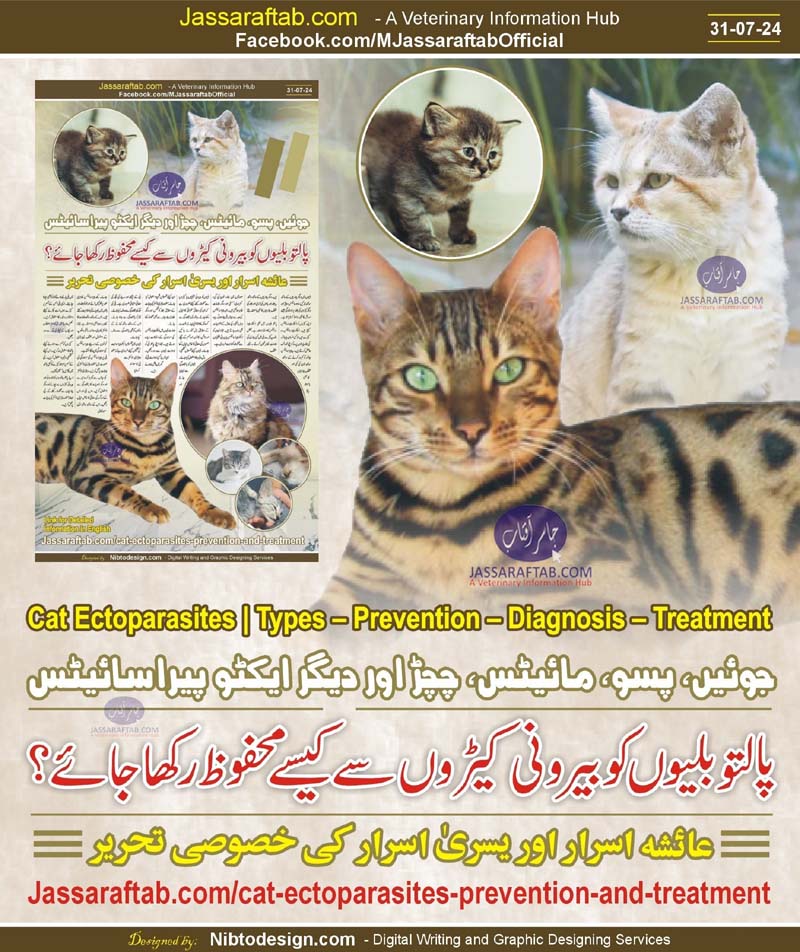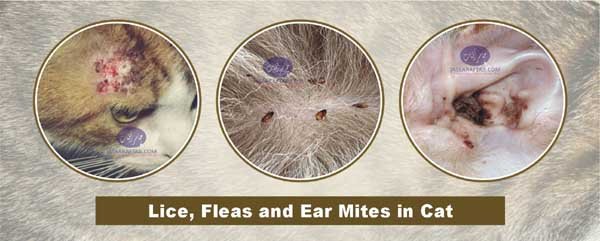Cat Ectoparasites | Types – Prevention – Diagnosis – Treatment
Like other animals, parasites like fleas, lice, ticks, and mites also live on the skin of cats. Besides causing weakness, weight loss, and certain skin problems, these cat ectoparasites may also cause different diseases. Moreover, these may also cause different diseases in pet owners. So prevention of cat ectoparasites including ticks in cats is essential for your pet’s health.
This article is written by Ayesha Israr and Yusra Israr, DVM Students at FVS BZU Multan
This article embarks on the diagnosis and treatment of cat ectoparasites. Moreover, this also focuses on how the owner can prevent the occurrence and spread of ectoparasites in their companion animals including ticks in cats.
پالتو جانوروں کو جلد کے مسائل سے کیسے محفوظ رکھا جائے
Ectoparasites and Cat Ectoparasites
All creatures have a special place in the complex circle of life, and cats, who are kept as pets are friends of millions of people worldwide nowadays, are no different. But behind the soft blanket of their fur, there is a secret world full of tiny but dangerous enemies called ectoparasites. These organisms, which are frequently disregarded despite their importance, have developed alongside felines, influencing their behavior, well-being, and interactions with their surroundings.
بلیاں پیلی کیوں ہو جاتی ہیں؟ ییلو فیٹ ڈیزیز کے حوالے سے ڈاکٹر عبدالوحید فاطم کی گفتگو
Ectoparasite by definition means those parasites that live on the body of their hos. They live on their skin or within hairs and fur. Moreover, they get their food by sucking on the blood (fleas, lice) or burrowing on the skin (mites). Ticks in cats are also important. These ectoparasites may cause detrimental effects to the hosts. These include potentially fatal anemia and itch- and non-itch (allergy) producing skin diseases.
If we talk about the prevalence of different ectoparasites in cats and ticks in cats, the most common is the fleas. Ticks fall on the second number. Moreover, Lice is on third.
Ticks in Cats:
Ticks in cats relate to different factors. In some areas, tick activity can be year-round. On the other hand, it usually peaks in the spring, summer, and early fall when temperatures are higher. However, factors including geographic location and local temperature conditions might affect the seasonal predilection for ticks in cats.
Spring and Summer: As temperatures rise and humidity levels climb, tick activity peaks in many areas. During this period, ticks become more active and seek hosts for blood meals. During these seasons, cats who spend time outside (especially in grassy areas) are more likely to come into contact with ticks.
Early Fall: If temperatures stay warm, there’s a chance that tick activity may continue to be high. Tick activity may still be present when the temperature cools off.
Winter: Tick activity usually declines in colder areas when temperatures dip below freezing in the winter. However, certain tick species like the Lyme disease-carrying black-legged tick (Ixodes scapularis) may continue to be active throughout milder winter months or in areas with somewhat moderate conditions.
Year-Round Risk: Ticks in cats can be found all year round in some areas, especially those with mild winters or where ticks are common.
Ticks in cats should be checked around and shoulders. Moreover, these may be found inside and behind the ear flaps and around the eyelids. They may also exist under all legs and between all toes. Ticks in cats should also be checked around the groin and at the bottom of the paws.
Hosts of Ectoparasites
Pet cats and dogs are prone to a number of diseases. Both infectious and non-infectious disorders affect them. Infectious illnesses can also be caused by bacteria (Brucellosis, Leptospirosis, etc.), fungi, viruses, and parasites. For example, feline panleukopenia also known as feline distemper caused by feline parvovirus (FPV). Cryptococcosis is a fungal disease that may affect the respiratory tract especially the nasal cavity in cats. According to studies the most important hosts of ectoparasites are dogs and cats.
Stray Cats and Cat Ectoparasites
Cats that live only outdoors and are not owned by humans as pets are known as free-roaming cats (Felis catus) or stray cats. These stray cats have usual encounter with domestic cats, and also such stray cats are in close proximity to homes. Unfortunately, these free-roaming cats do not receive any type of veterinary care or ectoparasitic treatments. But they remain an important population to study in relation to the health of domestic home-kept cats.
Losses due to Cat Ectoparasites
These cat ectoparasites can lead to the development of blood parasites in animals causing anemia. Most cat infections are asymptomatic. Although a variety of clinical symptoms. These symptoms include anemia, fever, lethargy, and splenomegaly, which may develop over time as a result of compromised immunity. Cat Ectoparasites have also economic impacts. The immediate costs of treating infestations and the costs of preventing infestations mainly affect the owner. Besides the wider economic effects on pet owners, veterinary practices, and society at large are all included in the economic significance of ectoparasites in cats and dogs.
اہم معلومات: پالتو جانوروں کا ویکسی نیشن شیڈول، کینل مینجمنٹ اور بہتر دیکھ بھال
Cat Ectoparasites Diagnosis:
Within the field of veterinary medicine, identifying ectoparasites in cats is a vital component of providing treatment for felines. These elusive creatures, which include fleas, ticks, and mites, can pose serious health and welfare hazards to our beloved feline friends since they frequently hide beneath their fur. For prompt intervention and efficient therapy, it is of great importance to understand the methodologies and procedures utilized in the diagnosis of ectoparasitic infestations. The variety of parasites that may infect animals, each with distinct traits and a distinct life cycle, contributes to the enigma surrounding ectoparasite identification.
The following factors affect the diagnosis of ectoparasite:
Variety of Species: There are many different species of ectoparasites, and each is suited to a particular host and environment. Understanding these parasites, behavior, and preferred habitats is necessary for identification.
Adaptations and Camouflage: Many ectoparasites have developed strategies to conceal themselves in the hair or skin of their hosts, several parasites have developed adaptations to avoid being discovered, such as burrowing under the skin or hiding in cracks.
Complexity of Lifecycle: Ectoparasites have intricate life cycles that may involve several stages (e.g., egg, larva, nymph, adult) and several hosts.
Symptom Overlap: It can be difficult to diagnose ectoparasite infestations since their clinical symptoms often resemble those of other skin disorders or illnesses. Testing and close inspection are necessary to distinguish symptoms linked to ectoparasites.
Emerging Species and Resistance: As a result of global migration and environmental changes, new ectoparasite species may appear in various locations. Furthermore, some parasites become resistant to conventional therapies, making detection and control even more difficult.
پاکستان میں پالتو جانوروں کی جدید طریقوں سے افزائش میں ترقی
Methods of Cat Ectoparasites Diagnosis
Ectoparasite identification is crucial in preserving feline health. Both visual examination and sophisticated laboratory testing play key roles in accurate diagnosis. For an accurate diagnosis, advanced laboratory tests as well as visual inspection are essential.
Understanding the parasite in question and its life cycle is crucial for diagnosing ectoparasitic infestation or ectoparasite-associated dermatosis. Certain parasites, like lice, are easily discovered on the skin of their hosts. In many instances, diagnosing ectoparasite infections is easier than diagnosing endoparasite illnesses. Ticks in cats and other animals are an example of an ectoparasite that is huge and mostly stationary.
Nevertheless, due to their small size, cryptic lifestyle, or the fact that the clinical signs they cause in their host, can be mistaken for other infections or conditions. There are several ectoparasites that affect humans, companion animals, and production animals that are still challenging to diagnose. Traditional diagnostic procedures that involve the direct identification of a parasite, such as microscopic analysis of skin scrapings or hair pricks are frequently applied.
Diagnosis is done by 2 methods for a quick realization of ectoparasites:
Ectoparasite observed by full body search and body comb.
The ear swabs are examined for the presence of parasitic mites.
Visual Inspection:
Direct Observation: Pet owners or veterinarians can visually examine a cat’s ears, skin, and fur to look for evidence of ectoparasites such as mites, fleas, ticks, or lice.
Clinical Signs: Itching, redness, hair loss, or visible parasites on the skin are common signs of ectoparasite infections. Finding these indicators is aided by visual inspection.
Advanced Laboratory Examinations:
Microscopic Inspection: In order to accurately identify some ectoparasites, such as lice and mites, microscopic inspection may be necessary. To find these parasites, skin scrapings or hair samples can be examined under a microscope.
Molecular Testing: Even in situations when a visual inspection may not be able to definitively identify an ectoparasite, the Polymerase Chain Reaction (PCR) and other molecular tests can offer an accurate diagnosis. By identifying DNA or RNA sequences unique to certain parasites, these assays improve the precision of diagnosis.
Blood testing: To identify infections like ehrlichiosis or Lyme disease that are spread by blood-borne ectoparasites like certain ticks, blood testing may be required.
Importance of accurate Cat Ectoparasites Diagnosis:
Benefits include effective treatment, preventing the spread of diseases, preventing secondary consequences, and preserving general health.
To sum up, accurate ectoparasite identification is ensured by combining visual inspection with advanced laboratory testing, which results in efficient treatment and the maintenance of feline health.
Cat Ectoparasites Treatment
In the treatment of ectoparasite in cats main aim is to eliminate the adults by the topical use of certain insecticides and acaricides followed by a bath with a feline or a baby shampoo. In case of ear mites cleaning the ear with ear swabs and certain herbal formulations available in the market for this purpose; baby oil can also be used.
Cat Ectoparasites Prevention:
Prevention of ectoparasites in cats can be done mainly by breaking the life cycle of these parasites. Owners should make it sure that their pet cats should not come in contact with the free-roaming or stray cats as they act as a carrier for most of the ectoparasites causing infestation in cats. Moreover, taking care of the hygiene of the cats i.e. proper grooming done by the comb followed by a regular bath with a proper feline shampoo. Ears should be cleaned after regular intervals to avoid ear-mites infestation. Cat ectoparasite care involves a lot of litter management, especially when it comes to preventing flea infections.
Flea Lifecycle Interruption, Lowering the Population of Fleas, Environmental treatment, Monitoring for infestation, Preventing Secondary Infections, and Improving Cat Comfort are some of the ways to prevent serious situations occurring from ectoparasites.
It is imperative that cat owners use biosecurity and biosafety precautions to avoid contracting ectoparasite infections. Here are some self-defense strategies for cat owners.
پالتو جانوروں کی قوت مدافعت کی بہتری کے موضوع پر سیمینارز کا انعقاد
Personal Protective Techniques:
When handling cats, especially if they are known to have ectoparasites or ticks in cats, wear long sleeves and gloves. To prevent coming into close contact with parasites, use flea combs or tick removal instruments carefully. After interacting with cats, especially before eating or touching the face, thoroughly wash your hands with soap and water. Moreover, regular pet check-ups from vets, staying in touch with vets, and environmental control strategies are also helpful in avoiding the risk of infestation of owners.
By implementing these biosecurity and biosafety measures, cat owners can reduce the risk of getting infected by ectoparasites and ticks in cats. By taking these steps, they can ensure the health and well-being of both themselves and their feline companions.











